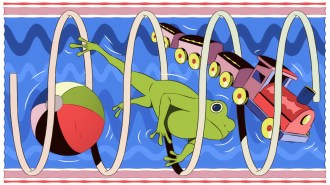Superfluids are weird liquids that flow with no friction and can perform fantastic feats, such as spontaneously crawling over the walls of containers. Theorists have proposed that quantum-mechanical interactions among even a few atoms can give rise to such behaviors.

Now, researchers in Canada have evidence for the onset of superfluidity in a droplet containing a mere seven atoms of liquid helium-4. For now, isotopes of helium are the only substances known to exhibit superfluidity, which appears at temperatures just above absolute zero (SN: 9/23/00, p. 207: Available to subscribers at Hydrogen hoops give superfluid clues).
Wolfgang Jäger and Yunjie Xu of the University of Alberta in Edmonton and A. Robert W. McKellar and Jian Tang of the National Research Council of Canada in Ottawa joined forces to make the discovery. The scientists observed signs of superfluid behavior in successively larger groupings of helium-4 atoms, starting with three atoms and building up to a cool dozen.
In past experiments, other scientists have used a similar approach to demonstrate that superfluidity can appear when as few as 60 helium-4 atoms are present (SN: 4/25/98, p. 271).
The Canadian researchers created the helium groupings so that each one was clustered around a molecule of nitrous oxide, better known as laughing gas. Microwave and infrared radiation set the molecule spinning and vibrating.
The first six helium atoms to accumulate are essentially dragged along with the rotating molecule at about 10 billion revolutions per second, Jäger says.
Helium atom number 7, however, altered the picture dramatically. The additional atom not only didn’t join the merry-go-round, but its presence also somehow lessened the connections between the other six helium atoms and the nitrous oxide. Slippage started appearing between the spinning molecule and the surrounding helium–a first hint of frictionless flow–and continued with additional helium-4 atoms.
Jäger, McKellar, and their colleagues report their results in the Oct. 17 Physical Review Letters.
These new findings may be the first direct observation of superfluidity setting in as helium-4 atoms pile up to form a droplet, Jäger says. The observations also illuminate the physical nature of liquid-helium droplets engulfing molecules, he adds.
Some theorists regard these minuscule droplets as a mixture of two fluids–a normal fluid and a superfluid. Others argue that the droplets constitute a single superfluid of uneven density.
The new data “provide a far more interesting and demanding test of [superfluidity] theory than any previous experiment,” says Kevin K. Lehmann of Princeton University, a proponent of the single-superfluid point of view.
Theorist K. Birgitta Whaley of the University of California, Berkeley points out that the new data actually fit nicely with previous theoretical studies based on the two-fluid model.
****************
If you have a comment on this article that you would like considered for publication in Science News, send it to editors@sciencenews.org. Please include your name and location.






